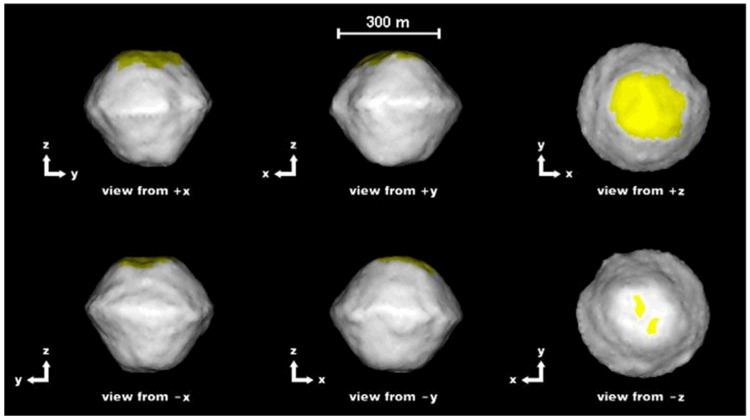Discovery date 4 March 2008 Observation arc 768 days (2.10 yr) Eccentricity 0.083561 Inclination 7.4366° Mean anomaly 303.16° MPC designation 341843 | Alternative names 2008 EV5 Aphelion 1.0384 AU (155.34 Gm) Discovered 4 March 2008 Argument of perihelion 234.82° | |
 | ||
Semi-major axis 0.95832 AU (143.363 Gm) Similar (66391) 1999 KW4, (175706) 1996 FG3, 162173 Ryugu, (33342) 1998 WT24, 25143 Itokawa | ||
(341843) 2008 EV5 is a near-Earth, potentially hazardous, Aten asteroid 400 m (1,300 ft) in diameter. It was discovered by the Mount Lemmon Survey in Tucson, Arizona, United States, on 4 March 2008.
Contents
Physical characteristics
2008 EV5 is an oblate spheroid 400 m (1,300 ft) in diameter. It rotates very slowly in a retrograde direction. There is a 150 m (490 ft) diameter concave feature, possibly an impact crater, or a relic feature from a previous episode of rapid rotation that caused the asteorid's shape to reconfigure. Visible and near-infrared spectroscopy show that 2008 EV5's composition is similar to that of carbonaceous chondrite meteorites. 2008 EV5 is listed in the JPL Small-Body Database and classified as: Aten NEO, PHA (SPK-ID: 2341843).
Sample return mission
2008 EV5 is the preliminary baseline target of a proposed sample-return NASA mission called ARM. Besides the asteroid 2008 EV5, several other asteroids, including Itokawa and Bennu, are being considered for this mission.
Origin and orbital history
2008 EV5 started its existence as part of a much larger body in the asteroid belt, with a likely diameter greater than 100 km. 2008 EV5's immediate history likely started when its parent body experienced a large cratering event or, more likely, a catastrophic disruption event that resulted in a highly fractured, shattered, or reaccumulated object (rubble pile). As a result, 2008 EV5 may have been produced as a reassembly of ejected fragments. The location of what is now 2008 EV5 within this parent body is unknown.
Given the available modeling work and data, the most plausible source family candidates for 2008 EV5 are Eulalia, New Polana, and Erigone. This assumes that 2008 EV5's true albedo is considerably lower than 10%. If 2008 EV5 does have a high albedo, a plausible source would be a population of high-albedo C-type asteroids in the inner asteroid belt. Second tier candidate families for the high-albedo case are Baptistina and Pallas.
From here, the newly liberated 2008 EV5 began to change via the forces referred to as the Yarkovsky and YORP effects. The Yarkovsky effect describes a small force that affects orbital motion. It is caused by sunlight; when objects heat up in the Sun, they reradiate the energy away as heat, which in turn creates a tiny thrust. This recoil acceleration is much weaker than solar and planetary gravitational forces, but it can produce substantial orbital changes over timescales ranging from many millions to billions of years. The same physical phenomenon also creates a thermal torque that probably caused 2008 EV5 to take on a top-like appearance
Dynamical models indicate that 2008 EV5 migrated inward across the inner asteroid belt over long timescales (i.e. the order of ~0.01–1 Gyr) until it reached a planetary gravitational resonance that drove it into the near-Earth asteroid (NEA) population over a timescale of the order of ~1 Myr. From there, gravitational interactions with both the planets and resonances allowed it to reach its current orbit within a few Myr to a few tens of Myr.
On 23 December 2008, 2008 EV5 made a close approach to Earth at a distance of 8.4 lunar distances (0.022 AU, 3.2 million km), its closest until 2169.
